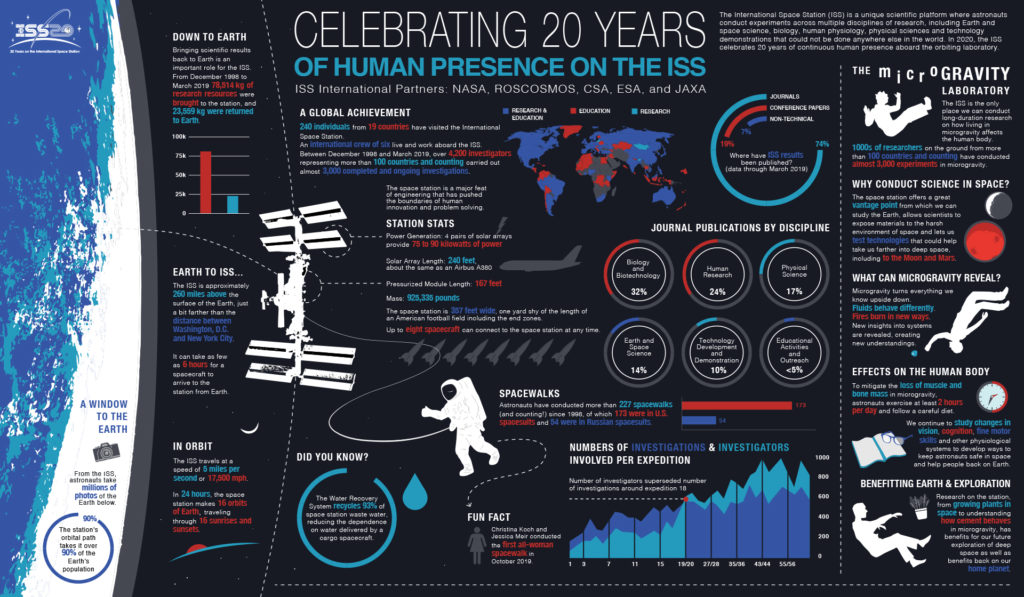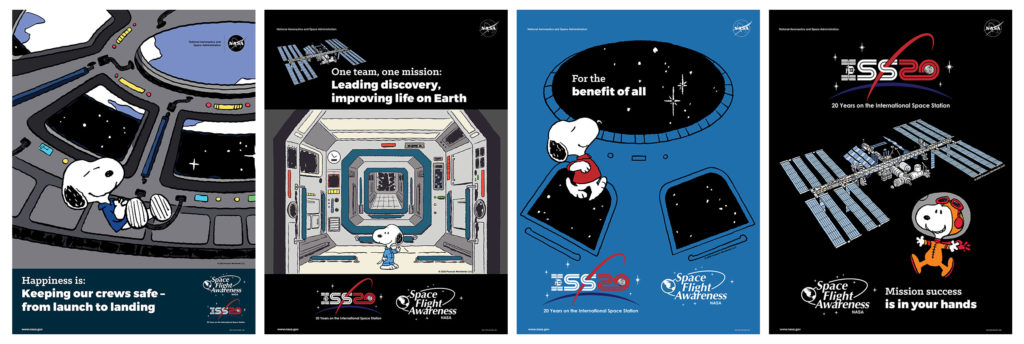Lots of media news this week, as the ISS celebrates 20 years [on November 2] of continuous human presence aboard the orbiting laboratory.
• Overview of operations [PDF]

The ISS is approximately 260 miles above the surface of the Earth, just a bit farther than the distance between Washington, D.C. and New York City.
The space station is 357 feet wide, one yard shy of the length of an American football field including the end zones.
Up to eight spacecraft can connect to the space station at any time.
[Publications]
Biology and Biotechnology
Earth and Space Science
Human Research
Technology Development and Demonstration
Physical Science
Educational Activities and OutreachIt can take as few as 6 hours for a spacecraft to arrive to the station from Earth.
The ISS travels at a speed of 5 miles per second or 17,500 mph.
In 24 hours, the space station makes 16 orbits of Earth, traveling through 16 sunrises and sunsets.
The Water Recovery System recycles 93% of space station waste water, reducing the dependence on water delivered by a cargo spacecraft.
• NASA > Johnson Space Center > “NASA Collaborates with Peanuts Worldwide in Celebration of International Space Station’s 20th Anniversary” by Heather Kinney (October 15, 2020)
NASA is weeks away [on November 2] from 20 years of continuous human presence on the International Space Station (ISS). In celebration, the NASA Space Flight Awareness Program (SFA) and the International Space Station (ISS) Program partnered with Peanuts Worldwide, LLC, to develop a unique product series featuring your favorite Beagle!
• YouTube > NASA > “A Bridge Above: 20 Years of the International Space Station” (Aug 10, 2020)
“What if we built a bridge, between and above all nations, to jointly discover the galaxy’s great unknowns?” Join us this fall as we prepare to celebrate the 20th anniversary of the International Space Station. As a global endeavor, 240 people from 19 countries have visited the unique microgravity laboratory, which has hosted more than 2,800 research investigations from scientists in over 100 nations.
• New NASA Space Flight Awareness posters


Memorable moments for the orbital outpost …
YouTube > ESA > “International Space Station: 20 years in 60 seconds” (Nov 2, 2020)
An achievement of international cooperation …
YouTube > ESA > “Space Station 20th: astronauts celebrate humans’ home in space” (Nov 2, 2020)
A useful visual of spacecraft docked at the ISS, as well as an overview of ongoing experiments by Cygnus.
• NASA Space Flight.com > “NG-14 Cygnus departs ISS, kicks off busy year for Station crew” by Tyler Gray (January 6, 2021)
Station configuration following arrival of CRS-21 – credit NASA
ISS video, like fly over
• YouTube > VideoFromSpace > “Watch SpaceX’s Cargo Dragon approach space station in stunning time-lapse” (Dec 8, 2020) – SpaceX’s upgraded Cargo Dragon spacecraft captured footage of its approach to the International Space Station on Dec. 7, 2020. Credit: SpaceX | mash mix by Space.com’s Steve Spaleta.
Cf.
• YouYube > NASA Video > “Expedition 64 SpaceX CRS 21 Automated Docking – December 7, 2020”